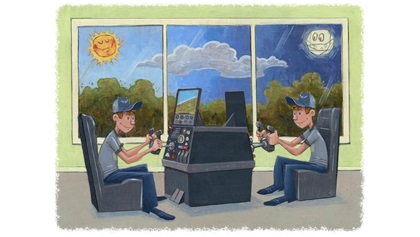Sim City
A piston pilot tries for a jet type rating

Illustrations by John Sauer
There may be an alarm, too, but the series of calamitous events in the last 30 seconds leaves me so stunned that I honestly can’t say.
It’s my second day of Cessna Citation M2 training inside FlightSafety International’s full-motion simulator, and I’ve managed to crash the incredibly realistic, state-of-the-art training device. This accident is no fender-bender, either. A computer readout shows the airplane was traveling at more than 300 knots in a steep dive at the moment of impact.
“That’s what runaway trim will do for you,” my instructor, a retired airline pilot, says as he magically erases my fiery death with a few strokes on his touchscreen computer. The glass-panel cockpit obediently returns to the stable, predictable condition in which it had been a minute earlier: on autopilot, in a steady descent, while I reprogrammed the avionics for a newly assigned IFR approach to an airport in Kansas.
“Runaway trim can sneak up on you—especially when flying single pilot,” he says. “You didn’t notice until the autopilot kicked off, and by then it was too late. The elevator overpowered you.”
He asks if I want a do-over on this emergency scenario, and I answer “yes” before he can finish the question. Anything to cleanse the horrid mental image of my mistake and the ensuing crash.
I was nearing the midpoint in FlightSafety International’s 15-day training course for what I hoped would be my first jet type rating. During the first few days, the classroom and sim sessions had progressed relatively smoothly—but in less than one disastrous minute, my chances of successfully completing the course seemed very much in doubt.
I took a deep breath and tried to shake off my blunder. I still had a pair of oddball approaches to fly in this sim session—an NDB and a localizer back course—and they’d require my full attention. In a few moments, the simulator was bumping along again in what looked and felt like a cloudy night, indicating 250 knots in a shallow descent.
I tried to push the crash out of my mind, but my instructor was still at the crash scene.
 “You went for the circuit breaker first and that cost you,” he said. “It doesn’t help to do the right thing if you do it in the wrong order.”
“You went for the circuit breaker first and that cost you,” he said. “It doesn’t help to do the right thing if you do it in the wrong order.”
I’m 58 years old and have been flying for decades, but mostly in impractical airplanes. Aerobats, vintage airplanes, and warbirds drew me to aviation, and that’s where I’ve stayed. A jet type rating was attractive, however, because it allowed me to become a student again, and I hoped some formal education would expand the breadth of aviation subjects I can knowledgably write about. The only jet I’d ever flown as pilot in command, however, was the diminutive SubSonex JSX–2 sport jet—an airplane that shares little with the M2 other than a taste for kerosene.
My course began several weeks in advance with online ground school and a series of quizzes that covered M2 systems. I made a thick stack of index cards to help me memorize the unfamiliar airplane’s weights and operating limitations as well as its electrical, pneumatic, hydraulic, and avionics systems. The prep material was well organized and succinct, and interactive graphics helped explain the complex mechanical interactions that take place under the airplane’s skin. I’d never flown an M2, or even sat in the left seat of one, before attending the course, so no information was too basic.
I signed up for single-pilot training because I’ve never flown an airplane that required two pilots. Single-pilot type training would be more demanding in some ways, but at least I wouldn’t have to learn to fly as a crewmember at the same time I was learning a new airplane. The single-pilot strategy allowed me to keep some of my deeply ingrained old habits—but not all of them.
My pilot behavior would have to change in some fundamental ways if I was to have any chance of mentally keeping pace with the M2, by far the highest flying (41,000 feet) airplane I’d ever been around. I’d be forced to let go of the casual informality that had always been part of my way of flying.
The first week of training was mostly spent in the classroom. During that time, I spent hours “chair flying” and memorizing the emergency procedures I expected to see in the simulator. By the time we got to the motion simulator, I had some of them down cold. The first time an engine fire took place in the simulator, I recalled the tasks and performed them without hesitation—or consulting a checklist.
Idle power on the affected engine; press the Fire button to shut off the fuel and hydraulic flow and arm the halon fire suppression bottle; extinguish the fire with halon; move the power lever on the affected engine to idle cutoff; select bleed air crossflow; and transfer fuel to the operating engine.
I thought my instructor, Dale Nickerson, would be pleased with my quick action, but the veteran Gulfstream pilot wasn’t happy at all.
“Get out the checklist and go step by step,” he said. “Don’t rush, and don’t improvise. The airplane’s moving fast, so you’ve got to slow down. If you hurry, you’re going to make a bad situation much, much worse.”
I also ran afoul of my instructors by being too willing to cast aside some of the advanced avionics features. They want you to use automation as much as possible. I’m spring loaded to dumb it down, or turn it off. When I couldn’t convince the Garmin G3000 to fly a procedure turn at a waypoint before beginning an instrument approach, I simply put the autopilot in heading mode, crossed the fix, spun the dial to my outbound heading, and started the timer.
 “That’s one way to do it,” a chagrined instructor observed. “A better way would be to program the box correctly.”
“That’s one way to do it,” a chagrined instructor observed. “A better way would be to program the box correctly.”
During a circling approach, I descended as low as legally allowed, saw the landing runway, then clicked off the autopilot and hand flew the rest of the procedure.
“Pretty good, but the G3000 is better,” he said. “It’s got a faster chip than the one in your brain, and it’s way more consistent than any human. Learn how to use it to your advantage.”
Jack Wishart, an instructor and designated examiner, launched into a lecture about crew resource management that I considered irrelevant for my purposes. After all, I was pursuing a single-pilot rating. Wishart rolled his eyes like only a New Yorker can.
“Single-pilot CRM may seem like an oxymoron but it’s not,” he said. “Every time you turn the autopilot on or off, make it a positive transfer of the controls just like you’d do with a crewmember. Make sure the autopilot is doing what you expect it to do, and confirm it before you focus your attention elsewhere. Just because you’ve pressed a button doesn’t mean you’ve completed a task.”
Training days fell into a familiar rhythm. Morning classroom. Simulator briefing. Simulator session. Debrief.
Another M2 student generously allowed me to sit in on his simulator sessions, so I got to see each of them twice. Once from the backseat, and once from the left seat.
Each evening, I’d close myself in a quiet room with a non-motion procedures trainer and drill some more. Or I’d leave the emergencies behind and simply go through a normal flight. Those hours in the procedures trainer weren’t “loggable,” but with no time in a real jet they provided a baseline for normal operations. That normalcy made the simulated emergencies easier to understand and deal with.
By the time of the actual checkride, I’d spent 17 hours in the full-motion simulator and roughly twice that amount in the procedures trainer.
I felt thoroughly prepared by the instructors, and both the two-hour oral and 2.5-hour checkride (which took place in the full-motion sim) were largely anticlimactic. I even heard the examiner trying to suppress a few yawns in the simulator, a sure sign that a checkride was going well. It wasn’t perfect, but it was good enough.
I’m not sure I’ll know what to do in a fully functional airplane. My time in an M2 cockpit simulator has been characterized by cascading emergencies and one traumatic crash.
It’ll be a luxury to get in an airplane where both engines are running normally, there’s no wind shear, and the ceiling is above 200 feet.AOPA
Email [email protected]



